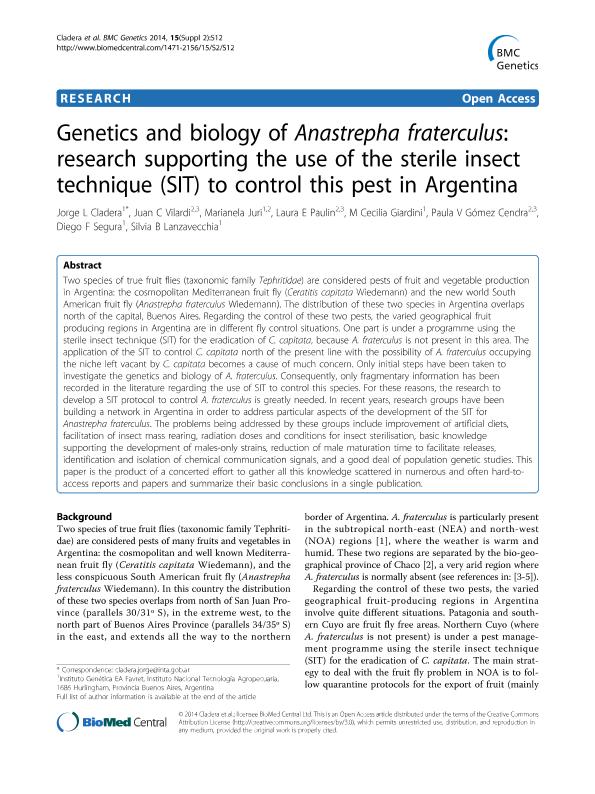Artículo
Genetics and biology of Anastrepha fraterculus: Research supporting the use of the sterile insect technique (SIT) to control this pest in Argentina
Cladera, Jorge Luis; Vilardi, Juan Cesar ; Juri, Marianela Lucia
; Juri, Marianela Lucia ; Paulin, Laura Elisa
; Paulin, Laura Elisa ; Giardini, M. Cecilia; Gómez Cendra, Paula Valeria
; Giardini, M. Cecilia; Gómez Cendra, Paula Valeria ; Segura, Diego Fernando
; Segura, Diego Fernando ; Lanzavecchia, Silvia Beatriz
; Lanzavecchia, Silvia Beatriz
 ; Juri, Marianela Lucia
; Juri, Marianela Lucia ; Paulin, Laura Elisa
; Paulin, Laura Elisa ; Giardini, M. Cecilia; Gómez Cendra, Paula Valeria
; Giardini, M. Cecilia; Gómez Cendra, Paula Valeria ; Segura, Diego Fernando
; Segura, Diego Fernando ; Lanzavecchia, Silvia Beatriz
; Lanzavecchia, Silvia Beatriz
Fecha de publicación:
12/2014
Editorial:
BioMed Central
Revista:
BMC Genetics
ISSN:
1471-2156
Idioma:
Inglés
Tipo de recurso:
Artículo publicado
Clasificación temática:
Resumen
Two species of true fruit flies (taxonomic family Tephritidae) are considered pests of fruit and vegetable production in Argentina: the cosmopolitan Mediterranean fruit fly (Ceratitis capitata Wiedemann) and the new world South American fruit fly (Anastrepha fraterculus Wiedemann). The distribution of these two species in Argentina overlaps north of the capital, Buenos Aires. Regarding the control of these two pests, the varied geographical fruit producing regions in Argentina are in different fly control situations. One part is under a programme using the sterile insect technique (SIT) for the eradication of C. capitata, because A. fraterculus is not present in this area. The application of the SIT to control C. capitata north of the present line with the possibility of A. fraterculus occupying the niche left vacant by C. capitata becomes a cause of much concern. Only initial steps have been taken to investigate the genetics and biology of A. fraterculus. Consequently, only fragmentary information has been recorded in the literature regarding the use of SIT to control this species. For these reasons, the research to develop a SIT protocol to control A. fraterculus is greatly needed. In recent years, research groups have been building a network in Argentina in order to address particular aspects of the development of the SIT for Anastrepha fraterculus. The problems being addressed by these groups include improvement of artificial diets, facilitation of insect mass rearing, radiation doses and conditions for insect sterilisation, basic knowledge supporting the development of males-only strains, reduction of male maturation time to facilitate releases, identification and isolation of chemical communication signals, and a good deal of population genetic studies. This paper is the product of a concerted effort to gather all this knowledge scattered in numerous and often hard-toaccess reports and papers and summarize their basic conclusions in a single publication.
Palabras clave:
A. Fraterculus
,
Biology
,
Genetics
,
Sit
Archivos asociados
Licencia
Identificadores
Colecciones
Articulos(IEGEBA)
Articulos de INSTITUTO DE ECOLOGIA, GENETICA Y EVOLUCION DE BS. AS
Articulos de INSTITUTO DE ECOLOGIA, GENETICA Y EVOLUCION DE BS. AS
Articulos(SEDE CENTRAL)
Articulos de SEDE CENTRAL
Articulos de SEDE CENTRAL
Citación
Cladera, Jorge Luis; Vilardi, Juan Cesar; Juri, Marianela Lucia; Paulin, Laura Elisa; Giardini, M. Cecilia; et al.; Genetics and biology of Anastrepha fraterculus: Research supporting the use of the sterile insect technique (SIT) to control this pest in Argentina; BioMed Central; BMC Genetics; 15; Suppl 2; 12-2014; 1-14
Compartir
Altmétricas



